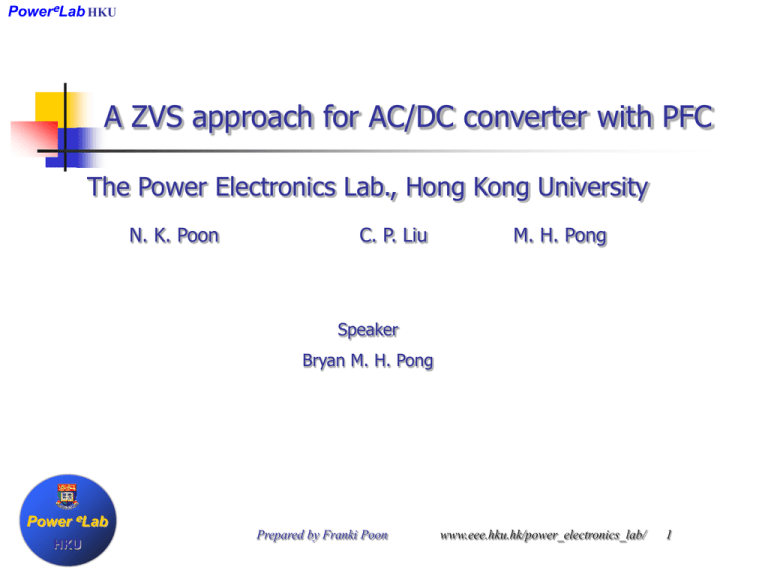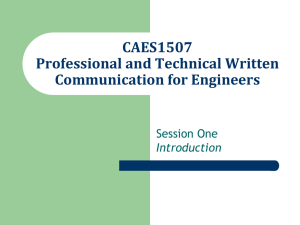A ZVS approach for AC/DC converter with PFC
advertisement

PowereLab HKU A ZVS approach for AC/DC converter with PFC The Power Electronics Lab., Hong Kong University N. K. Poon C. P. Liu M. H. Pong Speaker Bryan M. H. Pong Power eLab HKU Prepared by Franki Poon www.eee.hku.hk/power_electronics_lab/ 1 Some basic concepts Load Input rectifiers and capacitor produce Pulsating input current Harmonic currents are generated Power eLab HKU Prepared by Franki Poon www.eee.hku.hk/power_electronics_lab/ 2 A conventional method Ipfc Idc A boost converter and a DC/DC converter Power eLab HKU Prepared by Franki Poon www.eee.hku.hk/power_electronics_lab/ 3 A popular method among researchers Ipfc Idc Single stage design which combines the boost and the DCDC converters Power eLab HKU Prepared by Franki Poon www.eee.hku.hk/power_electronics_lab/ 4 Is single stage design always better? Let us take a look Power eLab HKU Prepared by Franki Poon www.eee.hku.hk/power_electronics_lab/ 5 Why two-stage design? •Advantage •Losses Ipfc2 + Idc2 •Fix DCDC input voltage •Controllable bulk voltage Ipfc Idc •Disadvantage •Need two controllers •One more MOSFET Power eLab HKU Prepared by Franki Poon www.eee.hku.hk/power_electronics_lab/ 6 Why single-stage design? •Advantage •One controller •One MOSFET less Ipfc •Disadvantage Idc •Losses (Ipfc + Idc)2 •High Idc at low line •Higher Ipfc •High current stress •High voltage stress Power eLab HKU Prepared by Franki Poon www.eee.hku.hk/power_electronics_lab/ 7 Good reasons for two-stage oTwo-Stage oSingle Stage •Advantages •Advantages •Losses Ipfc2 + Idc2 •One controller •Fix DCDC input voltage •One MOSFET less •Controllable bulk voltage •Disadvantages •Disadvantages •Need two controller •Losses (Ipfc + Idc)2 •One more MOSFET •High Idc at low line •Higher Ipfc •High current stress Power eLab •High voltage stress HKU Prepared by Franki Poon www.eee.hku.hk/power_electronics_lab/ 8 Our new idea Boost + Asymmetric half-bridge with soft switching M1 DMpfc > DM2 Mpfc M2 Power eLab HKU Prepared by Franki Poon www.eee.hku.hk/power_electronics_lab/ 9 Zero voltage state - M2 M1 turn off then . . Power eLab HKU Prepared by Franki Poon www.eee.hku.hk/power_electronics_lab/ 10 Zero voltage state - Mpfc After M2 turn on Power eLab HKU Prepared by Franki Poon www.eee.hku.hk/power_electronics_lab/ 11 Two separate converters M2 turn on Mpfc turn on Power eLab HKU Prepared by Franki Poon www.eee.hku.hk/power_electronics_lab/ 12 Zero voltage state – M1 M2 turn off Mpfc turn on Power eLab HKU Prepared by Franki Poon www.eee.hku.hk/power_electronics_lab/ 13 One cycle on asymmetric M1 turn on Mpfc turn on Power eLab HKU Prepared by Franki Poon www.eee.hku.hk/power_electronics_lab/ 14 One cycle on PFC M1 turn on Mpfc turn off Power eLab HKU Prepared by Franki Poon www.eee.hku.hk/power_electronics_lab/ 15 It’s great, but . . . If DMpfc < DM2 DMpfc = DM2 Power eLab HKU Prepared by Franki Poon www.eee.hku.hk/power_electronics_lab/ 16 After all – small Maux added M1 Mpfc For all DMpfc and all DM2 Maux M2 Power eLab HKU Prepared by Franki Poon www.eee.hku.hk/power_electronics_lab/ 17 Final timing arrangement M2 gate drive A M1 gate drive B Maux gate drive Mpfc gate drive VA = VB VMaux_ds = VA-VB =0 Power eLab HKU Prepared by Franki Poon www.eee.hku.hk/power_electronics_lab/ 18 Practical consideration M1 Mpfc Maux M2 Doff guarantee a path for Laux current when M2 off at any time Power eLab HKU Prepared by Franki Poon www.eee.hku.hk/power_electronics_lab/ 19 Practical circuit – O/P 12V@10A 250uH IRF840A Two diodes are used to clamp ringing STD5NM50 12uH 8uH STPS12NM50 STPS12NM50 Power eLab HKU Prepared by Franki Poon www.eee.hku.hk/power_electronics_lab/ 20 Simplified timing circuit L5991 M2 gate O/P Sync M1 gate Maux gate Sync Mpfc gate O/P L4981 Power eLab HKU Prepared by Franki Poon www.eee.hku.hk/power_electronics_lab/ 21 How does it look? Width = 12.6cm Depth = 6.3cm Height = 1.9cm Power eLab HKU Prepared by Franki Poon www.eee.hku.hk/power_electronics_lab/ 22 ZVS on M2 Power eLab HKU Prepared by Franki Poon www.eee.hku.hk/power_electronics_lab/ 23 ZVS on Mpfc Power eLab HKU Prepared by Franki Poon www.eee.hku.hk/power_electronics_lab/ 24 ZVS on Mpfc & M2 Power eLab HKU Prepared by Franki Poon www.eee.hku.hk/power_electronics_lab/ 25 Losses and Efficiency Power loss vs. Output power at 115V input Efficiency vs. Input voltage at 12V@10A output 16 12 Efficiency/% Power loss/W 14 10 8 6 4 2 0 0 24 48 72 96 120 Output power/W 100 98 96 94 92 90 88 86 84 82 80 90 100 115 150 200 230 240 Input voltage/V Power eLab HKU Prepared by Franki Poon www.eee.hku.hk/power_electronics_lab/ 26 Finally . . . •Simple Boost + Asymmetric Half-bridge configuration – Good Combination. •All ZVS behaviors – Very little added cost. •Two separate converter – Easy to control •Active diode can be incorporated – <1W no load power •Simple PWM controller – simple ASIC Power eLab HKU Prepared by Franki Poon www.eee.hku.hk/power_electronics_lab/ 27





